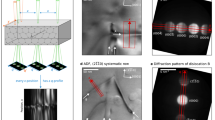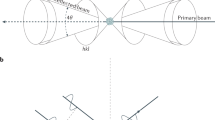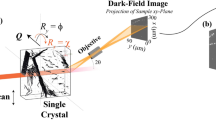Abstract
Among the diverse lattice defects occurring in natural diamonds, none has engendered so much controversy as the ‘platelets’, those planar defects which lie on {100} planes of the diamond matrix and whose diameters commonly lie in the range 10–100 nm. For many years, the only evidence for the existence of platelets was indirect, residing in the reported anomalous ‘spike’ diffuse X-ray reflections1, but it was eventually accepted that these diffuse reflections could not be due to thermal vibrations but arose from static lattice disorder2. Guinier3 and Frank4 independently pointed out that the defects responsible for the ‘spike’ reflections must be plate-like, lying in {100}. Direct proof of the existence of platelets came with the transmission electron microscope (TEM) observations of Evans and Phaal5, and it has been shown that the platelet structure is extrinsic, that is, that it forces apart the diamond matrix on either side of the platelet6. We now report a new and more reliable way of measuring the magnitude of matrix displacement produced by platelets.
This is a preview of subscription content, access via your institution
Access options
Subscribe to this journal
Receive 51 print issues and online access
$199.00 per year
only $3.90 per issue
Buy this article
- Purchase on Springer Link
- Instant access to full article PDF
Prices may be subject to local taxes which are calculated during checkout
Similar content being viewed by others
References
Raman, C. V. & Nilakantan, P. Proc. Ind. Acad. Sci. A11, 389–397 (1940).
Lonsdale, K. Proc. R. Soc. A179, 315–320 (1942).
Guinier, A. C. r. Acad. Sci., Paris 215, 114–115 (1942).
Frank, F. C. Proc. R. Soc. A237, 168–174 (1956).
Evans, T. & Phaal, C. Proc. R. Soc. A270, 535–552 (1962).
Evans, T. & James, P. F. Phil. Mag. 11, 113–129 (1965).
Mitsuishi, T., Nagasaki, H. & Uyeda, R. Proc. Jap. Acad. 27, 86–87 (1951).
Pashley, D. W., Menter, J. W. & Bassett, G. A. Nature 179, 752–755 (1957).
Lang, A. R. Nature 220, 652–657 (1968).
Lang, A. R. J. Crystal Growth 42, 625–631 (1977).
Walker, J. Rep. Prog. Phys. 42, 1605–1659 (1979).
Lang, A. R. in The Properties of Diamond (ed. Field, J.) 425–469 (Academic, London, 1979).
Lang, A. R., Proc. phys. Soc. Lond. 84, 871–876 (1964).
Evans, T. Diamond Research, 2–5 (Industrial Diamond Information Bureau, London, 1973).
Woods, G. S. Phil. Mag. 34, 993–1012 (1976).
Allen, B. P. & Evans, T. Proc. R. Soc. A375, 93–104 (1981).
Evans, T., Qi, Z. & Maguire, J. J. Phys. C14, L379–L384 (1981).
Author information
Authors and Affiliations
Rights and permissions
About this article
Cite this article
Bursill, L., Hutchison, J., Sumida, N. et al. Measurements of diamond lattice displacement by platelet defects with electron microscopic moiré patterns. Nature 292, 518–520 (1981). https://doi.org/10.1038/292518a0
Received:
Accepted:
Issue Date:
DOI: https://doi.org/10.1038/292518a0
Comments
By submitting a comment you agree to abide by our Terms and Community Guidelines. If you find something abusive or that does not comply with our terms or guidelines please flag it as inappropriate.



